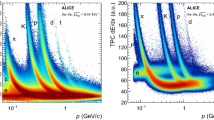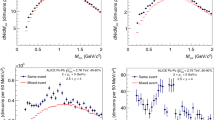Abstract
The inclusive spectra of pions and kaons produced in BeBe collisions as functions of their transverse momentum \(p_T\) at mid-rapidity are calculated within the approach, which is based on the assumption of the similarity of inclusive spectra of hadrons produced in AA collisions at their small transverse momenta in the mid-rapidity region. The essence of the modification of the self-similarity approach consists in the inclusion of a quark-gluon dynamics in hadron production in nucleon–nucleon interaction at mid-rapidity. We focus mainly on the ratio of cross-sections of \(K^\pm \) to \(\pi ^\pm \) mesons produced in BeBe collisions as a function of \(\sqrt{s}\). A fast rise of this ratio, when the initial energy increases starting from the kaon production threshold up to \(\sqrt{s}\simeq \) 20–30 GeV, is revealed together with its very slow increase up to LHC energies. The energy dependence of this ratio is due to the conservation laws of four-momenta and quantum numbers of the initial and produced hadrons and the Regge asymptotic behavior of the total and inelastic cross-sections of nucleon–nucleon collisions at large initial energies The satisfactory description of NA61/SHINE data on these ratios is demonstrated. Some predictions for RHIC and LHC on the \(K^+/\pi ^+\) and \(K^-/\pi ^-\) yield ratios as functions of \(\sqrt{s}\) in BeBe collisions as functions of \(\sqrt{s}\) are presented. The similarity of these observables to the ones for pp collisions at mid-rapidity and in the wide range of initial energies is illustrated.






Similar content being viewed by others
Data Availability Statement
This manuscript has no associated data or the data will not be deposited. [Authors’ comment: We have no own data and use the published data referred in our paper.]
References
S.V. Afanasiev et al., (NA49 Collaboration) Phys. Rev. C 66 (2002)
C. Alt et al., (NA49 Collaboration) Phys. Rev. C 77, 024903 (2008)
M. Gazdzicki, M.I. Gorenstein, Acta Physika Polon. B 30, 2705 (1999)
M. Gazdzicki, M.I. Gorenstein, P. Seyboth, J. Mod. Phys. E 23, 1430008 (2014)
J. Cleymans et al., NA49 Collaboration. Phys. Lett. B 615, 50 (2005)
A. Andronic, P. Braun-Muenzinger, J. Stachel, Nucl. Phys. A 772, 167 (2006)
A. Andronic, P. Braun-Muenzinger, J. Stachel, Phys. Lett. B 673, 142 (2013)
K.A. Bugaev et al., Europhys. Lett. 104, 22002 (2013)
R. Poberezhnyuk, M. Gazdzicki, M.I. Gorenstein, Acta Physika Polon. B 46, 1991 (2015)
A. Palmese, W. Cassing, E. Seifert, P. Moreau, E.L. Bratkovskaya, Phys. Rev. C 94, 044912 (2016)
D. Blaschke et al., Acta Phys. Polon. B Procc. Suppl 14, 485 (2021)
D. Blaschke et al., Phys. Rev. D 96, 094008 (2017)
K. Werner, F.-M. Liu, T. Pierog, Phys. Rev. C 74, 044902 (2006)
S. Bass et al., Prog. Part. Nucl. Phys. 41, 255 (1998)
M. Blreicher et al., J. Phys. G 25, 1859 (1999)
Z.-W. Lin et al., Phys. Rev. C 72, 06490 (2005)
Z.-W. Lin, Phys. Rev. C 90, 014904 (2014)
B. Zhang et al., Phys. Rev. C 61, 067901 (2000)
W. Cassing, E.L. Bratkovskaya, Phys. Rev. C 78, 034919 (2008)
W. Cassing, E.L. Bratkovskaya, Nucl. Phys. A 831, 215 (2009)
J. Mohs, S. Ryu, H. Elfner, J. Phys. G 47, 065101 (2020)
J. Weil et al., Phys. Rev. C 94, 054905 (2016)
A. Acharya et al., (NA61/SHINE Collaboration) Eurs. Phys. J. C 81, 73 (2021)
Wojciech Brylinski for the NA61/SHINE Collaborationes, EPJ Web Conf. Volume 258, 05007 (2022)
A. Acharya et al., NA61/SHINE Collaboration. Eur. Phys. J. C 81, 397 (2021)
A. Aduszkiewicz et al., (NA61/SHINE Collaboration) Phys. Rev. C 102, 011901(R) (2020)
B. Tomasik, E.E. Kolomeitsev, Eur. Phys. J. C 49, 115 (2007)
J.K. Nayak, S. Banik, j. Alam , Nucl.Phys. A 862-863, 286 (2011)
G.I. Lykasov, A.I. Malakhov, A.A. Zaitsev, Eur. Phys. J. A 57, 78 (2021)
A.M. Baldin, L.A. Didenko, Fortsch. Phys. 38, 261 (1990)
A.M. Baldin, A.A. Baldin, Phys. Parti. Nucl. 29(3), 232, 065101 (1998)
A.M. Baldin, A.I. Malakhov, A.N. Sissakian, Phys. Part. Nucl. 29(Suppl. 1), 4 (2001)
A.M. Baldin, A.I. Malakhov. JINR Rapid Communications, No.1(87)-98, pp.5-12 (1998)
A.A. Baldin, JINR Rapid Comm. No. 4[78]-96 p.61-68
E. Fermi, Phys. Rev. 92, 452 (1953)
I..Ya.. Pomeranchuk, Izv. Dokl. Akad. Nauk Ser. Fiz. 78, 889 (1951)
L.D. Landau, Izv. Akad. Nauk Ser. Fiz. 17, 51 (1953)
R. Hagedorn, Supplemento al Nuovo Cimento 3, 147 (1965)
D.A. Artemenkov, G.I. Lykasov, A.I. Malakhov, Int. J. Mod. Phys. A 30, 1550127 (2015)
G.I. Lykasov, A.I. Malakhov, Eur. Phys. J. A 54, 187 (2018)
A.I. Malakhov, G.I. Lykasov, Eur. Phys. J. A 56, 114 (2020)
A.M. Abdulov, H. Jung, A.V. Lipatov, G.I. Lykasov, M.A. Malyshev, Phys. Rev. D 98, 054010 (2018)
V.A. Bednyakov, A.A. Grinyuk, G.I. Lykasov, M. Pogosyan, Int. J. Mod. Phys. A 27, 1250042 (2012)
A.A. Grinyuk, G.I. Lykasov, A.V. Lipatov, N.P. Zotov, Phys. Rev. D 87, 074017 (2013)
A.V. Lipatov, G.I. Lykasov, N.P. Zotov, Phys. Rev. D 89, 014001 (2014)
N. Cartiglia. arXiv:1305.6131 [hep-ex]
S.H. Stark, Eur. Phys. J. (Web Conf.) 141, 03007 (2017)
E. Schnedermann, J. Sollfrank, U. Heinz, Phys. Rev. C 48, 2462 (1993)
G. Wilk, Z. Wlodarczyk, Phys. Lett. 84, 2770 (2000)
K.A. Bugaev, J. Phys .G. Nucl. Phys. 28, 1981 (2002)
K.A. Bugaev, M. Gadzicki, M.I. Gorenstein, Phys. Lett. B 544, 127 (2002)
J. Cleymans, G.I. Lykasov, A.S. Parvan et al., Phys. Lett. B 723, 351 (2013)
J.L. Kley et al., E895 Collaboration. Phys. Rev. C 68, 054905 (2003)
J. Cleymans, J. Struempfer, L. Tirko, Phys. Rev. C 78, 017901 (2008)
N. Abgrall et al., NA61/SHINE Collaboration. Eur. Phys. J. C 74, 2794 (2014)
K.A. Ter-Martirosyan, Sov. J. Nucl. Phys. 44, 817 (1986)
A. Adiszkiewicz et al., NA61/SHINE Collaboration. Phys. Rev. C 102(1), 011901 (2020)
B.I. Abelev et al., (STAR Collaboration) Phys. Rev. C 79, 034909 (2009)
A. Adare et al., (PHENIX Collaboration) Phys. Rev. C 83, 064903 (2011)
K. Aamodt et al., (ALICE Collaboration) Eur. Phys. J. C 71, 1655 (2011)
J. Adam et al., (ALICE Collaboration) Eur. Phys. J. C 75, 226 (2015)
A. Acharya et al., NA61/SHINE Collaboration. Eur. Phys. J. C 80, 961 (2020)
Acknowledgements
We are very grateful to K.A. Bugaev, M. Gumberidze, M. Gazdzicki, R. Holzmann, S. Pulawski, G.Pontecorvo for extremely helpful discussions.
Author information
Authors and Affiliations
Corresponding author
Additional information
Communicated by Che-Ming Ko.
Appendix
Appendix
The parameterizations of \(\sigma _{tot},\sigma _{SD}\) and \(\sigma _{el}\) have the following forms [46, 47]
In Fig. 6 the \(p_T\)-spectra of pions and kaons, produced in the mid-rapidity of BeBe collisions within the initial momentum range of (30–150)A GeV/c, fitted by the NA61 data, are presented. The black dashed line corresponds to the quark contribution, the blue dash-dotted curve is the gluon contribution and the red solid line is the sum of quark and nonperturbative gluon contributions. The parameters \(A_q,A_g\) and \(C_q,C_g\) were found from a fit of NA61/SHINE data and are presented in Table 1.
As it is shown in [39,40,41], the form of inclusive pion spectra versus \(p_T\) at mid-rapidity given by Eqs. (6–8) describes satisfactorily data in a wide range of \(\sqrt{s}\) at \(p_T<\) 2-3 GeV/c. Moreover, as it is shown in [42,43,44,45], the contribution of gluons to the pion spectrum is related to the gluon distribution at low \(Q^2=\) 1–2 (GeV/c)\(^2\), the use of which results in a satisfactory description of data on hard pp processes at LHC energies and of proton structure functions at low x. Therefore, we use Eqs. (4–7) for the description of data on pion \(p_T\)-spectra in BeBe collisions, only improving the fit of data.
As for \(K^\pm \) production in BeBe collisions at not large initial energies we take into account the additional contribution due to the one Reggeon exchange diagram, which has a \(\sqrt{s_{th}/s}\) dependence. It leads to modification of parameter \(A_q\) in the following form \(A_q(1+\sqrt{s_{th}/s})\), which can be approximated by \(A_q\text{ exp }(\sqrt{s_{th}/s})\). This correction vanishes at RHIC and LHC energies, however, it allows us to describe data at \(\sqrt{s}<\) 10 GeV satisfactorily.
Parameters \(A_q\) for \(\pi \), \(K^+\) and \(K^-\) meson production were found from the fit of NA61 data [23, 62] at initial energies \(P_{in}=\) (30–150)A GeV/c. Parameters \(A_g\) for \(\pi \), \(K^+\) and \(K^-\) meson production were found from the fit of NA61 data at \(P_{in}=\) 150A GeV/c. Other parameters \(C_q\) and \(C_g\) were taken from fits of NA61 data in pp collisions.
Rights and permissions
About this article
Cite this article
Lykasov, G.I., Malakhov, A.I. & Zaitsev, A.A. Ratio of kaon-to-pion production cross-sections in BeBe collisions as a function of \(\sqrt{s}\). Eur. Phys. J. A 58, 112 (2022). https://doi.org/10.1140/epja/s10050-022-00773-z
Received:
Accepted:
Published:
DOI: https://doi.org/10.1140/epja/s10050-022-00773-z




